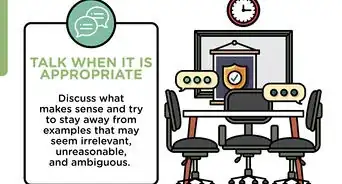This article was co-authored by Maya Diamond, MA and by wikiHow staff writer, Hunter Rising. Maya Diamond is a Dating and Relationship Coach in Berkeley, CA. She has 13 years of experience helping singles stuck in frustrating dating patterns find internal security, heal their past, and create healthy, loving, and lasting partnerships. She received her Master's in Somatic Psychology from the California Institute of Integral Studies in 2009.
There are 11 references cited in this article, which can be found at the bottom of the page.
wikiHow marks an article as reader-approved once it receives enough positive feedback. In this case, 97% of readers who voted found the article helpful, earning it our reader-approved status.
This article has been viewed 268,505 times.
If you want to get involved in deeper conversations, listening with your full attention helps you understand the topic better. Even if you think you’re already a good listener, it’s sometimes tough to engage with another person. Luckily, there are a few things you can do to stay focused on what the other person is saying. We’ll start with some tips on body language and move on to things you can say to make the other person feel heard.
Steps
Expert Q&A
Did you know you can get expert answers for this article?
Unlock expert answers by supporting wikiHow
-
QuestionWhat does it mean to actively listen?
 Maya Diamond, MAMaya Diamond is a Dating and Relationship Coach in Berkeley, CA. She has 13 years of experience helping singles stuck in frustrating dating patterns find internal security, heal their past, and create healthy, loving, and lasting partnerships. She received her Master's in Somatic Psychology from the California Institute of Integral Studies in 2009.
Maya Diamond, MAMaya Diamond is a Dating and Relationship Coach in Berkeley, CA. She has 13 years of experience helping singles stuck in frustrating dating patterns find internal security, heal their past, and create healthy, loving, and lasting partnerships. She received her Master's in Somatic Psychology from the California Institute of Integral Studies in 2009.
Relationship Coach
-
QuestionWhich of the following are ways you can listen for clues?
 Community AnswerAll of these strategies help you "read between the lines" and get to the meat of what a person is really trying to say. Watch body language, listen to tone of voice, and paraphrase to help clarify what the other person is saying.
Community AnswerAll of these strategies help you "read between the lines" and get to the meat of what a person is really trying to say. Watch body language, listen to tone of voice, and paraphrase to help clarify what the other person is saying. -
QuestionWhat if a person isn't being very open with you, how would you get a conversation going?
 Lala Montgomery (Student)Community AnswerTry to ask them some small questions first and keep going from there. As you talk, discuss your interests -- they might have the same ones!
Lala Montgomery (Student)Community AnswerTry to ask them some small questions first and keep going from there. As you talk, discuss your interests -- they might have the same ones!
Warnings
- Avoid making jokes or sarcastic comments while the other person is speaking since it can be distracting and take away from their emotions.[16]⧼thumbs_response⧽
- If someone doesn’t want to share information when you’re trying to dig deeper, don’t force them to talk. They might feel uncomfortable about the topic or want to keep it private.[17]⧼thumbs_response⧽
- Try your best not to get defensive about what someone says. If you disagree with them, try to consider things from their perspective.[18]⧼thumbs_response⧽
References
- ↑ https://www.forbes.com/sites/womensmedia/2012/11/09/10-steps-to-effective-listening/?sh=4f531ae93891
- ↑ https://www.forbes.com/sites/womensmedia/2012/11/09/10-steps-to-effective-listening/?sh=4f531ae93891
- ↑ https://www.canr.msu.edu/news/eye_contact_dont_make_these_mistakes
- ↑ https://today.duke.edu/2019/06/how-practice-active-listening
- ↑ https://www.adelaide.edu.au/writingcentre/sites/default/files/docs/learningguide-activelistening.pdf
- ↑ https://psychcentral.com/lib/become-a-better-listener-active-listening
- ↑ https://www.psychologytoday.com/us/blog/the-novel-perspective/202010/how-actively-listen-during-triggering-conversations
- ↑ https://raisingchildren.net.au/pre-teens/communicating-relationships/communicating/active-listening
- ↑ https://www.psychologytoday.com/us/blog/in-it-together/202006/active-listening-skills
- ↑ https://www.adelaide.edu.au/writingcentre/sites/default/files/docs/learningguide-activelistening.pdf
- ↑ https://psychcentral.com/lib/become-a-better-listener-active-listening
- ↑ https://psychcentral.com/lib/become-a-better-listener-active-listening
- ↑ https://ggia.berkeley.edu/practice/active_listening
- ↑ https://ggia.berkeley.edu/practice/active_listening
- ↑ https://www.psychologytoday.com/us/blog/the-right-balance/201610/are-you-really-listening-or-just-waiting-talk
- ↑ https://www.psychologytoday.com/us/blog/in-it-together/202006/active-listening-skills
- ↑ https://psychcentral.com/lib/become-a-better-listener-active-listening#The-Art-of-Questioning
- ↑ https://www.adelaide.edu.au/writingcentre/sites/default/files/docs/learningguide-activelistening.pdf
About This Article
To be an active listener, start by squarely facing the person you’re talking to and lean in with open posture to indicate that you’re listening. Keep your arms at your side so you don’t seem closed off. Then, engage with the other person by paraphrasing their answers or asking them open-ended questions like, “What was that like?” Remember to keep your attention on them and not get distracted by your phone or other conversations. To learn more about how to actively listen, like how to mirror the person you’re talking to, read on!











































































